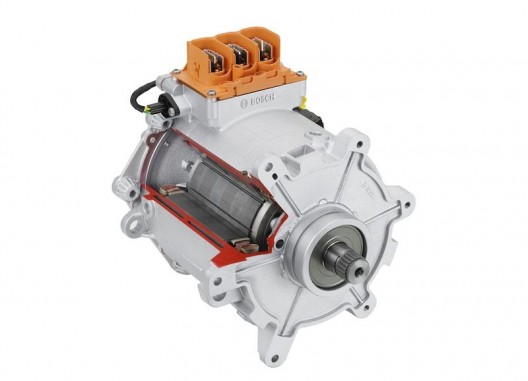Combine a FIAT 500e with an autogyro and you get the Cavalon, a two-seat, side-by-side, relatively quiet electric flying machine. Both use the same Bosch motor and inverter. Auto Gyro The Aircraft Company, Cavalon’s maker, says the 80 kilowatt motor drives a three-blade propeller at up to 2,300 rpm and provides performance similar to that for the Rotax-powered version of the craft.
A Bosch 180/120 SMG (separate motor generator) with a planetary gear propeller speed reduction powers the aircraft. Capable of regenerative braking on the little FIAT as controlled by an INVCON 2.3 inverter, it will be interesting to see if such recharging can be expected when the Cavalon glides. The motor/controller combination powers the FIAT 500e, the electric Smart Car, and is used to help drive the rear wheels on the Peugeot 3008 Diesel HYbrid4.
Compact like the cars and autogyro it drives, the motor gets its designation from its 180 millimeter diameter, a little over seven inches, and 120 millimeter length (4.6 inches). Its makers claim it could fit into a “typical school backpack,” although the kid might complain about lugging around its 32-kilogram (70.4 pound) heft.
The Cavalon’s battery pack is composed of Kokam prismatic cells storing 16.2 Amp-hours of energy and can feed the motor a maximum of 400 Volts. The high voltage accounts for the motor’s 12,000 rpm top speed and its requisite reduction drive for the propeller. For a high-speed motor, the 180/120 provides impressive torque, 200 Newton-meters (147.5 foot-pounds).
eCavalon’s first flight took place on June 24 at the Hildesheim airfield. Company president Otmar Birkner says, “Today we flew tomorrow’s aircraft. For now we share the same challenges for endurance as the automotive industry but in time, this will increase from the current 45 minutes and the future will become the present.”
The video is a year old and depicts a flight in a Rotax-powered Cavalon, but shows off the roomy cockpit and excellent visibility to advantage. Autogyros are also capable of autorotating down to a small landing space.
Comparable to the FIAT and Smart Cars, the Cavalon is only 4.7 meters (15.2 feet) long, 1.8 meters (5.9 feet) wide, and 2.8 meters (9.2 feet) high, topped by its 8.4 meter (27.5 feet) rotor. Its roomy cockpit will allow occupants to enjoy the view at its 145 kilometers per hour (90 mph) cruise. Top speed is 160 km/hr. (99.2 mph). The 80 kW (107 horsepower) motor should rival performance by the Rotax 912 ULS with 100 hp. or the 914 UL turbo with 115 hp.
Part of the Niedersachsen Aviat, a consortium of North Saxony aviation firms, The AutoGyro Group describes itself as, “A world leader in the development, production and distribution of Gyroplanes. Since its foundation in 1999, the ultra-light aircraft specialist has enjoyed constant growth and now has a team of highly qualified specialists and engineers. With a global network of distributors in over 40 countries, AutoGyro aims to deliver unlimited and safe flying enjoyment to its clients with the versatile gyroplanes.”
If the Bosch powerplant lives up to its goal for this application, gyrocopters could become much quieter in the near future.




Comments 4
By my calculations on useful load of a Rotax-powered Cavalon and weight of the Bosch electric powertrain vs a Rotax 912 ULS, a Bosch-powered eCavalon should have capacity for a 260 lb battery pack and still provide the 400 lb useful load for pilot, passenger, and baggage featured by a Rotax-powered Cavalon with full fuel.
Coincidentally, 260 lb is the weight of Pipistrel’s Alpha Electro battery pack, which has 17 kWh energy and enables 90 minutes flight endurance (without reserves).
Interesting that the proof-of-concept eCavalon has only half the flight endurance of the Alpha Electro with identical battery weight capacity and same Kokam battery tech. Higher lift/drag for the Alpha Electro would explain some of the difference. Also, the eCavalon might not have as much battery capacity despite the ability to carry the same 260 lb of batteries.
(Editor’s Note: Bill Lofton is author of EV Hangar (www.evhangar.com), a growing database of motors, controllers, aircraft, and accessories related to electric flight. It is an excellent resource for those wanting additional technical information beyond the news presented in the CAFE Blog.)
Is there a single-seater electric autogyro currently available….
(Editor’s Note: Not known. Anyone? Anyone?)
My name is Raymond. Iam a would be gyrocopter flyer. Q. Has anyone considered the amassing Phinergy battery. Basically, a battery that extends the electric or hybrid car up to 1500 Kim on a single charge. And it weighs 1/10th that of ion batteries.
Please, only positive feedback. I have chosen to focus on positive energy . I am focused on what WORKS not what does NOT. SO I DO NOT NEED TO KNOW WHAT DOES NOT WORK.
Rev Raymond Pilon
I am obviously not a scientist or mechanical engineer, but why can’t the rotors be used to create a brushless motor/ generator. Is it that they are too low rpm or that the drag created would “cost” more than the free energy they provide.
I don’t understand why the free wheeling rotors can not be used to either trickle charge the batteries or be used as direct assistance for the electric motor. I would be grateful if someone could explain with the maths attached.
I don’t own an autogyro, am scared of heights but it is something I have always dreamed of flying
(Editor’s Note: Cavalon has tried powering an autogiro with an electric motor, but hasn’t shared whether they used the rotor to recharge the batteries. http://www.auto-gyro.com/chameleon/public/0cf14de7-aaf2-59ef-c3d4-91145c1a49d3/24-06-2015_Press-release_AutoGyro-flies-electric.pdf )